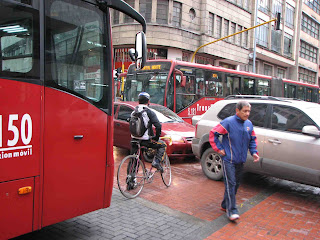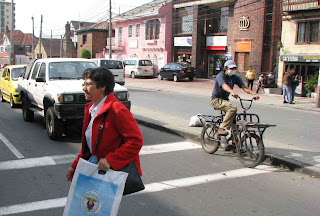 |
| EnCicla riders ready to roll. (Photo: Medellin Transit Dep't) |
Bogotá would appear to lend itself more to public bicycles: it's a big, flat, dense city with a reputation as a cycling pioneer - and lots of traffic jams. But Medellin has been rolling forward with its program, called EnCicla, while Bogotá's is parked.
Jesus David Acero, the program's administrator and an official with Medellin's transit office, said Medellin's program has succeeded thanks to careful groundwork and planning -and most of all support from municipal and regional officials.
Medellin had cycling experts design its system, Acero said, and used specially-designed bicycles, together with software to manage the system.
 |
| Medellin's pre-designed bicycles. (Photo: Medellin Transit Dep't) |
Still, Bogotá's public bike test program, called BiciBog, was quite well received and got good use - at least in its north Bogotá station. The south Bogotá trial received less demand, perhaps because many of the residents in the lower-income area have their own bicycles, as well as because of competition there from bicitaxis.
But Bogotá officials haven't indicated when or whether they'll continue the system. Acero says, however, that officials from the administration of incoming leftist Bogotá mayor Gustavo Petro have indicated interest in creating a public bike program here.
Meanwhile, Medellin's public bike program is still technically in its pilot stage, but has been extended until March of 2012 and expanded from being available to only the students of two universities to the public in general. Not one of the bikes, which are equipped with GPS trackers, has been stolen.
Currently, the program has 145 bicycles, 105 of which are in the city and 40 in a rural park area and 11 parking stations. Users pay nothing and get to use the bikes for one hour at a time. Those who go over the limit lose borrowing privileges for three days.
 |
| Bogotá's public bicycles in action. They weren't designed for shared use, however. And they're now collecting dust. (Despacio.org) |
The Medellin government "will have a hard time not expanding the public bikes program," Acero says, "because it's been very well accepted."
But Acero expresses lots of frustration about Bogotá's lack of progress. In fact, at this writing the folks in charge of BiciBog have yet to deliver their final report, which has been postponed at least once.
EnCicla's Facebook Page.
By Mike Ceaser, of Bogotá Bike Tours






















































